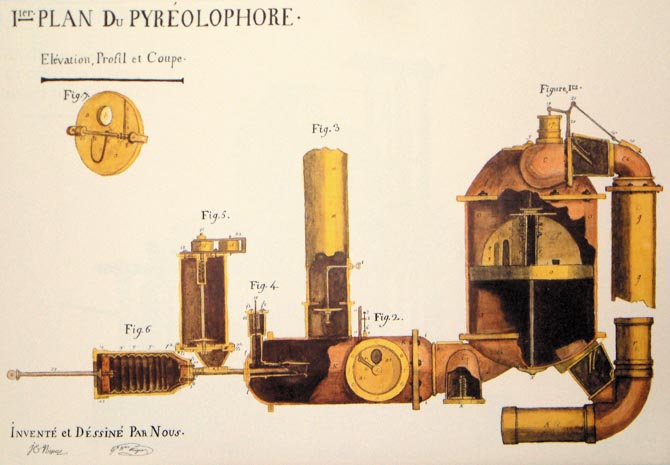Steam engines enjoyed an incredible evolution over a period of 100 years, progressing from racing horses to speeds of over 200km/h, but at the same time, technology was moving in other directions. Inventors were creating the very first internal combustion engines, and the world would never be the same again.
As with steam power, the history of internal combustion engines is clearly not linear. This is even more noticeable with internal combustion engines, since steam power development strongly increased the number of different inventors and engineers, especially compared to the Huygens-Papin period.
It’s nevertheless possible to identify a main road map, as we will try to demonstrate below.
Before starting, let’s clarify the term ‘internal combustion’. Remember, in a steam engine, whether ‘atmospheric’ or ‘high pressure’, the combustion takes place within a firebox and heats a secondary fluid – most often water – in a way to expand itself and work into one or several cylinder(s), or through a turbine: this is an External Combustion Engine (ECE). Other kinds of ECE exist, with hot air engines (Stirling, Ericsson) the best known, as we will see a little bit later.
In an Internal Combustion Engine (ICE), the combustion takes place inside the cylinder (or the engine core itself for gas turbines), and the gases involved in the combustion are directly expanded for working via a piston or a turbine without any intermediary fluid. This is simpler, cheaper and more efficient, as we will see.
Although we’re focusing more on piston engines, internal combustion engines also include, among others, Wankel rotary engines, gas turbines, turboshafts, turbojets, ramjets and rocket engines.
Clearly ahead of their own respective times – and prior to thermodynamics and Sadi Carnot’s theories – several pragmatic inventors elaborated, built and successfully ran the first internal combustion engines at the very beginning of the 19th century. Let’s speak about two of the main protagonists.
Introducing François Isaac de Rivaz
François Isaac de Rivaz, born in Paris in 1752, was a French-Swiss artillery officer, politician and inventor who invented a hydrogen-powered internal combustion engine with electric ignition (manually driven). He described this new engine in a French patent published in 1807.
In 1808, de Rivaz fitted it into a primitive working vehicle – the world’s first internal combustion powered automobile, tested in Valais (Switzerland). Why ‘internal’ instead of ‘external’ combustion? This came probably from de Rivaz’s army experience with cannons, which led him to think about using an explosive charge to directly drive a piston. Doesn’t it remind you a certain Huygens in the 1670s?
The difference is that now – around 130 years later – the knowledge and experience made it possible to turn the idea into an operational engine, without the intermediary of steam.
Introducing Nicéphore Niépce
Nicéphore Niépce, originally known as Joseph, is a celebrated French inventor, credited with being the inventor of photography (1820s). Along with his brother Claude, the Niépce brothers are also known for creating Pyréolophore, the first marine internal combustion engine.
Pyréolophore, Ou nouvelle Machine dont le principe moteur est l’air dilaté par le feu (A new Machine whose driving principle is air dilated by fire) was the title of the patent application written by the Niépce brothers in 1807, which was granted by Napoleon Bonaparte on 20 July 1807 [Niépce House Museum].
The Niépce brothers were living in Nice when they began their project to create an engine based on the newly defined principle of hot air expanding during an explosion. The challenge was to find a way to harness the energy released in a series of explosions [Niépce House Museum]. In 1806 the Niépce brothers presented a paper on their research to the French National Commission of the Academy of Science (French: Institute National de Science).
The Commission’s verdict was: “The fuel ordinarily used by MM. Niépce is made of lycopodium spores, the combustion of which is the most intense and the easiest; however this material being costly, they replaced it with pulverized coal and mixed it if necessary with a small portion of resin, which works very well, as was proved by many experiments.”
In Nicéphore and Claude’s machine, no portion of heat is dispersed in advance; the moving force is an instantaneous result, and all the fuel effect is used to produce the dilatation that causes the moving force.

This last consideration could be seen as a preliminary step toward the coming work from Sadi Carnot. Reporting for the commission, along with C. L. Berthollet in 1806, was a certain Lazare Carnot, father of Sadi Carnot.
Both operational engines from de Rivaz and the Niépce brothers are simultaneous concrete and genius examples coming from early 19th century, that show a first step toward understanding – in a pragmatic way – the key advantages of internal combustion over external combustion, particularly steam. And remember, this is very much ahead of what is considered the ‘time’ associated with these engines: the very first steam locomotive dates from the same period (1803).
Barsanti-Matteucci and other important innovations
As mentioned, several other inventors proposed internal combustion engines during the first half of the 19th century, among which included lighting gas and hydrogen engines. Many of them were stationary but were systematically opposed to the already existing and implanted steam machines.
Other ‘pre-Lenoir’ engines and/or ideas include:
- Wright hydrogen engine (1833)
- Barnet Engine (1838)
- Barsanti & Mateucci (1857)
The Barsanti-Matteucci engine was, in its simplest realization, a vertical cylinder in which an explosion of a mixture of air and hydrogen or an illuminating gas shot a piston upwards, creating a vacuum in the space underneath. When the piston returned to its original position, due to the action of the atmospheric pressure, it turned a toothed rod connected to a sprocket wheel and transmitted movement to the driving shaft.
This concept will be further picked up later by two other very famous inventors, as we’ll see over the coming weeks when we dive further into the history of the internal combustion engine.














